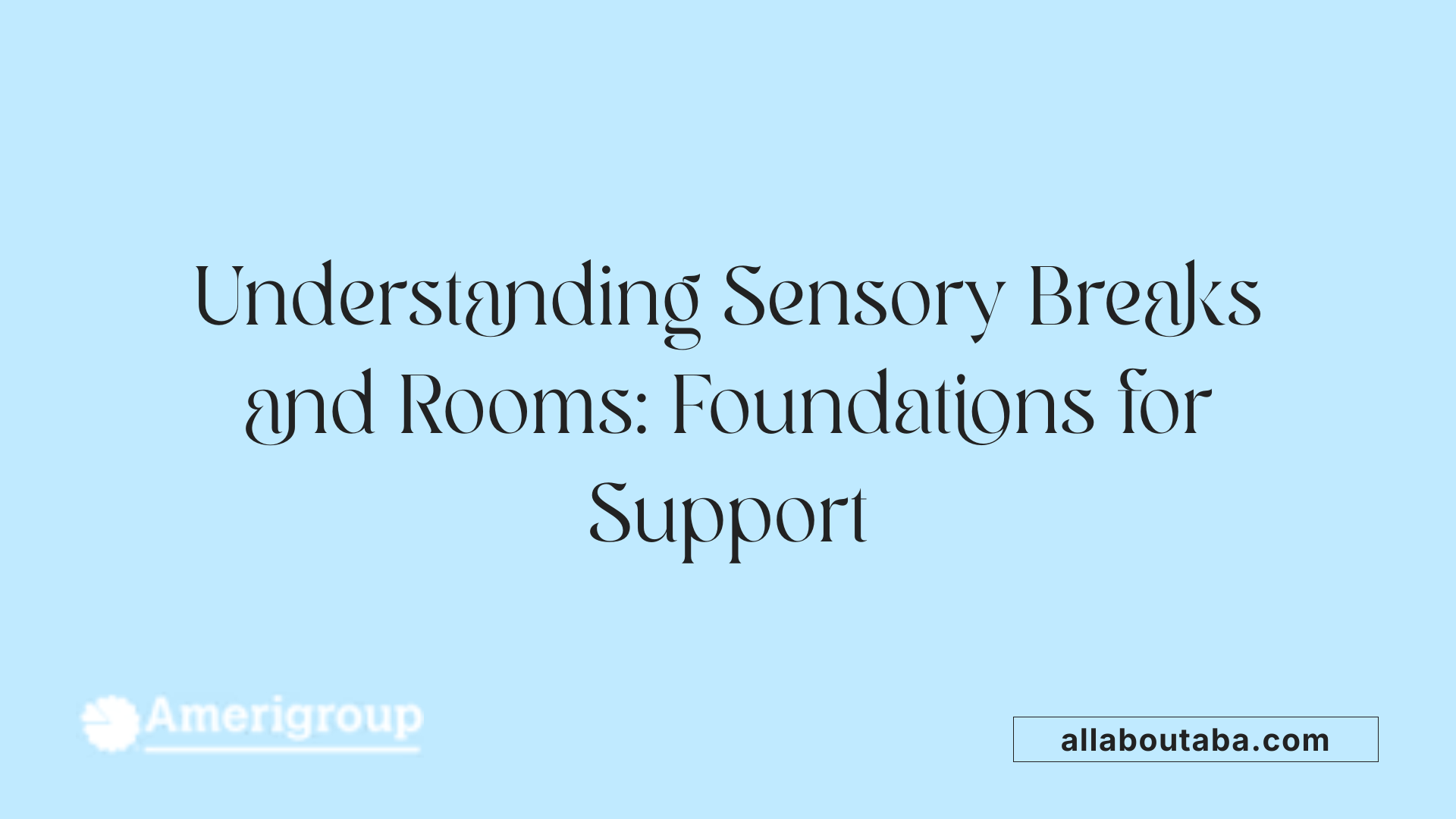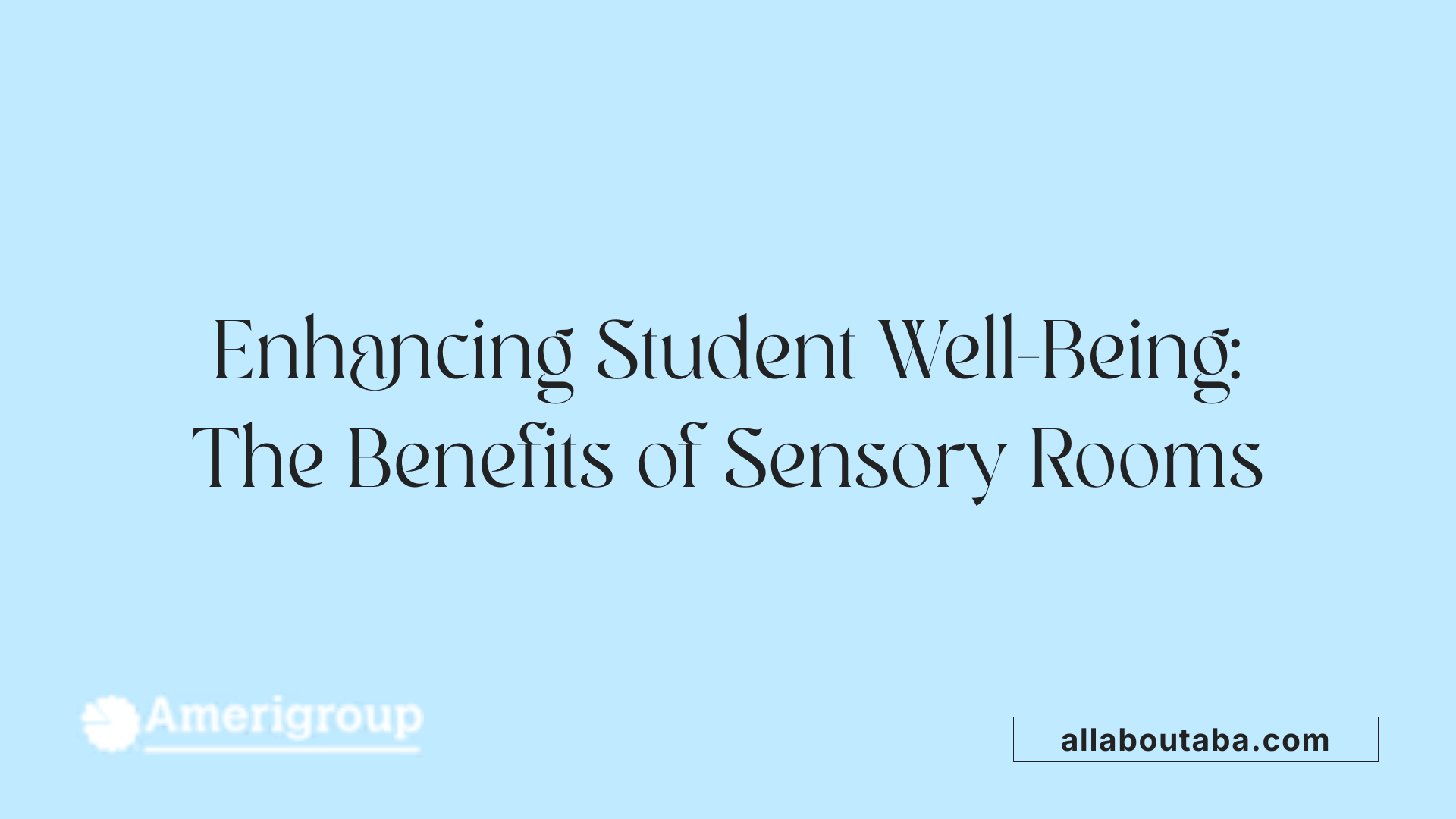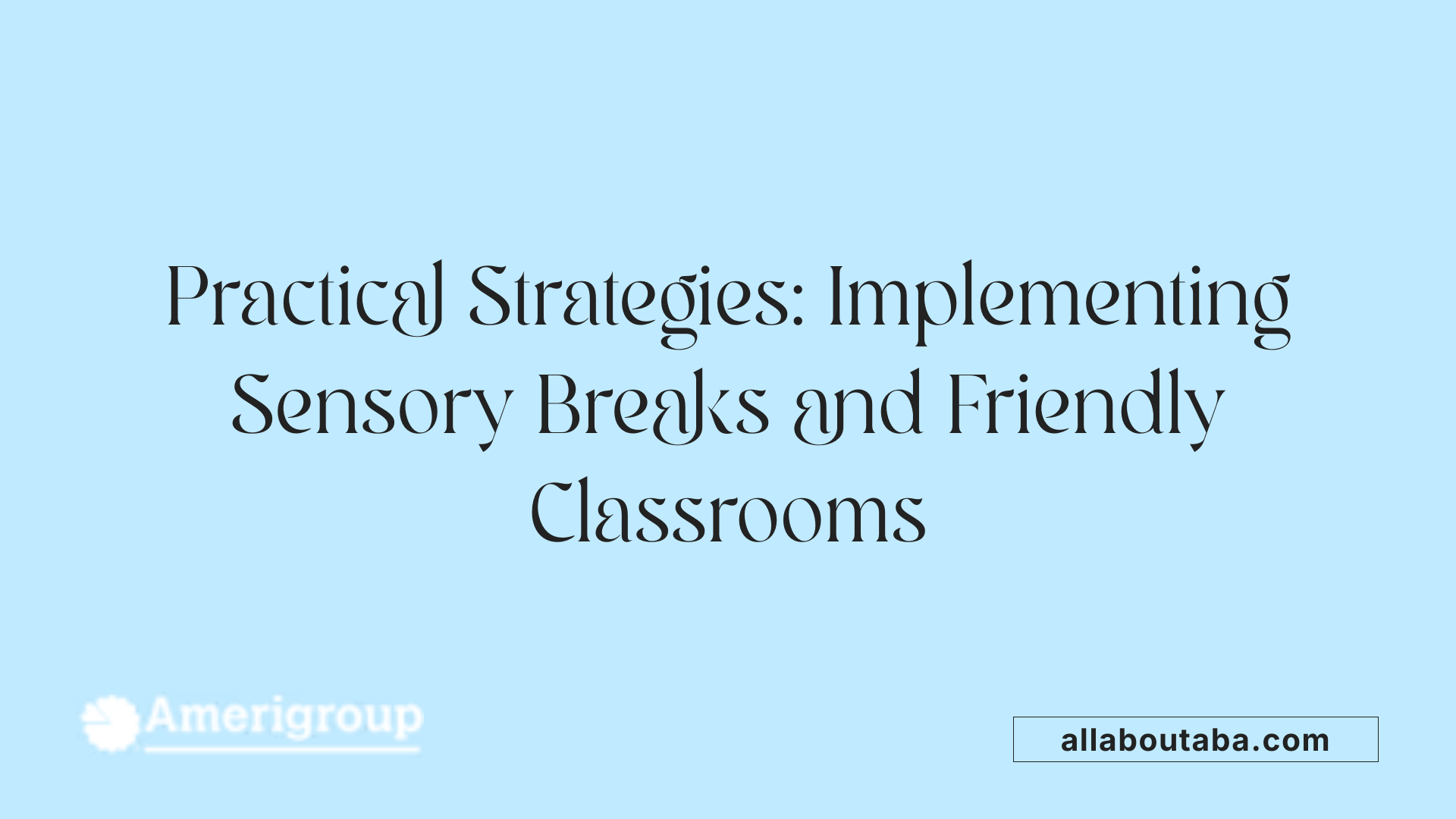Understanding the Role of Sensory Break Spaces in Schools
Sensory break spaces are emerging as vital tools in educational settings, designed to support students—especially those with autism spectrum disorder (ASD) and other sensory processing challenges. These dedicated environments and activities help students regulate their sensory input, promoting focus, emotional balance, and social engagement. This article explores how schools can thoughtfully incorporate sensory break spaces, the therapeutic benefits they offer, and how these measures integrate with broader behavioral therapies like Applied Behavior Analysis (ABA).
What Are Sensory Breaks and Sensory Rooms?

Definition and purpose of sensory breaks
Sensory breaks are brief, structured pauses during the day designed to help students restore focus and improve self-regulation by balancing their sensory input. Depending on whether a child is experiencing overstimulation or understimulation, these breaks include calming or alerting activities tailored to their sensory needs. By integrating sensory breaks, schools support students in maintaining emotional and sensory regulation, preventing overload and enhancing concentration.
Sensory rooms as therapeutic spaces
Sensory rooms are specialized therapeutic environments equipped with various sensory tools and equipment intended to promote positive behavioral and emotional change in students, especially those with sensory processing difficulties or disorders such as Autism Spectrum Disorder (ASD). These rooms provide a safe, controlled space where students can calm down, refocus, and develop self-regulation skills. Their design often incorporates adjustable elements to accommodate individual sensory preferences and needs.
Types of activities facilitated in sensory rooms
Activities in sensory rooms are diverse and specifically tailored to meet each student's sensory and therapeutic needs. Common activities include bouncing on therapy balls, hitting punching bags, climbing into body socks, swinging on platform swings, throwing slam balls, and jumping onto crash pads. These activities supply proprioceptive, vestibular, tactile, and deep-pressure input essential for sensory integration and emotional regulation.
Key sensory equipment and their role
Sensory rooms are equipped with a variety of tools such as weighted blankets, bean bags, bubble tubes, fiber optic lighting, image projectors, and sensory bins. These items offer different types of sensory stimulation—visual, tactile, auditory, or proprioceptive—that help students modulate their sensory experiences. For instance, weighted items provide calming deep-touch pressure, while fidget tools and textured materials support focus and engagement. The thoughtfully designed combination of these sensory aids targets enhanced self-regulation and emotional well-being in students within an educational setting.
Benefits of Sensory Rooms in Schools

How do sensory rooms improve self-regulation and focus?
Sensory rooms provide therapeutic environments equipped with specialized tools that promote self-regulation in students, particularly those with sensory processing challenges. Individualized activities such as bouncing on therapy balls, swinging on platform swings, or using tactile equipment help students balance their sensory input. These controlled sensory experiences reduce overstimulation, enabling students to calm down and regain focus. Research supports that sensory rooms enhance participation and help prevent behavioral escalations by offering a structured sensory break lasting from 5 to 15 minutes.
In what ways do sensory rooms enhance social-emotional skills and communication?
By offering a safe and familiar space, sensory rooms foster improved communication and social-emotional development. Students gain opportunities to practice interactions within a less restrictive environment, increasing their confidence and social exchanges. The calming setting reduces anxiety and behavioral challenges, enabling students to better express emotions and build resilience. Programs involving occupational therapy often incorporate these rooms to develop both fine and gross motor skills, further supporting social engagement.
How do sensory rooms create safe and calming environments?
The design of sensory rooms includes features such as adjustable lighting, sound-absorbing materials, and tactile elements like weighted blankets and bean bags, all intended to create an atmosphere that minimizes sensory overload. These spaces serve as retreats from noisy, bright classrooms, allowing students to regulate their sensory experiences effectively. Placement near classrooms ensures accessibility while maintaining good acoustics and visual privacy.
How do sensory rooms support student independence and resilience?
Schools incorporating sensory rooms emphasize developing tailored self-regulation plans that encourage students to recognize their own sensory needs and utilize appropriate tools independently. Through repeated use and guided activities, students build resilience by learning to manage anxiety and sensory overwhelm autonomously. Involvement of parents, teachers, and occupational therapists ensures comprehensive support and promotes students’ confidence in self-care strategies.
| Benefit Area | Description | Examples of Implementation |
|---|---|---|
| Self-Regulation & Focus | Provides sensory input balancing to reduce overload and improve attention. | Therapy balls, swings, sensory breaks |
| Social-Emotional Skills & Communication | Safe space encouraging interaction and emotional expression. | Calm environments, occupational therapy sessions |
| Safe & Calming Environments | Designed with adjustable lighting and sound control to minimize sensory triggers. | Weighted blankets, sound panels, dimmable lights |
| Independence & Resilience | Promotes student self-awareness and use of sensory tools for managing emotions and behavior independently. | Customized self-regulation plans, stakeholder involvement |
Designing and Equipping Effective Sensory Rooms

Physical design considerations: lighting, acoustics, and space layout
Creating an effective sensory room starts with thoughtful physical design. Lighting should be adjustable, incorporating features such as dimmable lights and blackout curtains to allow personalization for calming or alerting environments. Acoustics play a crucial role; the use of sound-absorbing materials like acoustic panels and soft fabrics helps minimize overstimulation from noise, fostering a peaceful atmosphere.
The layout should ensure the room is spacious enough to accommodate various activities, with easy access and good flow. Positioning sensory rooms near classrooms enhances accessibility, while ensuring that the space remains distinct enough to reduce sensory distractions.
Sensory integration equipment examples: therapy balls, swings, weighted blankets
A well-equipped sensory room contains a variety of tools to cater to individual sensory processing needs. Equipment such as therapy balls, platform swings, and punching bags offer opportunities for deep pressure input and movement activities, which are essential for self-regulation.
Weighted blankets and compression walls provide calming, deep-touch experiences that soothe and help reduce tension. Additional items might include bean bags, tactile sensory bins, and crash pads to support both fine and gross motor skills development.
Adaptive and adjustable sensory elements
Flexibility is vital in sensory room design. Sensory equipment and environmental elements should be adjustable to align with the specific needs of each student. For example, lighting controls allow for variability between brighter, alerting settings and dimmer, calming atmospheres.
Similarly, sound controls and tactile features like adjustable compression may be tailored during therapy sessions or regular use, helping students gain better self-regulation.
Incorporating tactile, visual, and auditory stimuli
Incorporation of multi-sensory stimuli enhances the therapeutic potential of the room. Visual features such as bubble tubes, fiber optic lighting, and image projectors create engaging and soothing visual effects.
Tactile stimuli can include textured walls, fidget tools, and sensory bins filled with varying materials to encourage exploration and sensory input. Auditory elements might involve soft music or noise-canceling headphones to control sound input.
These combined stimuli support diverse sensory needs and encourage positive sensory experiences within a safe, controlled setting.
Implementing Sensory Breaks and Sensory-Friendly Classrooms

What Are Structured Sensory Break Activities Both Indoors and Outdoors?
Sensory breaks involve planned activities that provide sensory input tailored to either calm or stimulate a student depending on their needs. Indoor activities can include heavy work like bouncing on therapy balls, playing with sensory bins, or engaging in tactile play. Outdoor options might involve swinging on platform swings, participating in movement clubs, or conducting sensory scavenger hunts. These breaks last typically 5-15 minutes and help restore focus and self-regulation.
How Can Classrooms Be Adapted to Meet Sensory Needs?
Sensory-friendly classrooms use several adaptations to reduce sensory overload. Physical modifications include minimizing clutter, dimming lights with adjustable options like blackout curtains, and using muted colors. Teaching adjustments involve predictable routines, regular movement breaks, quiet corners, and flexible seating arrangements. Incorporating these changes fosters a calm and supportive learning environment.
What Is the Collaborative Role of Teachers, Parents, and Occupational Therapists?
Creating and maintaining effective sensory environments requires teamwork. Teachers observe behavioral cues and implement classroom adaptations. Parents provide insight into the child's sensory preferences and reinforce strategies at home. Occupational therapists guide the development of self-regulation plans and recommend specific sensory tools and activities. This comprehensive approach ensures sensory accommodations align with each student's unique needs.
How Are Tools Like Fidget Toys, Movement Breaks, and Quiet Corners Used?
Sensory tools are vital for everyday self-regulation. Fidget toys and discreet tactile items can be used at desks to reduce anxiety and improve concentration. Movement breaks integrate energizing stretches or brain gym exercises within classroom routines. Quiet corners provide tranquil spaces equipped with weighted blankets and calming sensory materials where students can reset when overwhelmed.
Integrating these strategies through collaboration and customized sensory supports promotes inclusion and enhances student well-being and learning outcomes.
Integrating ABA Therapy Principles with Sensory Supports
What is Applied Behavior Analysis (ABA) therapy?
Applied Behavior Analysis (ABA) therapy is a scientific approach targeting behavior change by reinforcing positive behaviors and reducing unhelpful ones. It is customized extensively to meet individual needs, especially for persons with autism spectrum disorder (ASD). ABA focuses on the interplay between antecedents, behaviors, and consequences to promote development of skills such as communication, social interaction, and daily living. It is delivered across various settings—home, school, or community—and involves continuous data tracking to adapt interventions efficiently. This therapy prioritizes building on strengths, providing choices, and making progress enjoyable while fostering independence.
How does ABA therapy help individuals with autism?
ABA therapy assists individuals with autism by carefully breaking down complex skills into manageable steps. Positive reinforcement and repetition support acquisition of communication, social, and self-care skills. Techniques like Discrete Trial Training and Pivotal Response Treatment provide structured, natural learning opportunities. Early and intensive ABA interventions can yield meaningful gains in independence and behavior management, improving long-term functioning.
What are common ABA techniques relevant to sensory regulation?
Several ABA strategies can support sensory regulation: discrete trial training for targeted behavior acquisition; prompting and fading to encourage responses; and natural environment teaching to generalize skills. Reinforcement techniques boost desired sensory behaviors. Additionally, collaboration with occupational therapists can integrate sensory integration methods, linking behavioral targets with sensory needs. For example, behavior chaining might help a student learn to use a sensory room independently, while reinforcing self-regulation behaviors to reduce sensory overload.
How can ABA providers collaborate with sensory space implementation?
Collaboration between ABA therapists and sensory room facilitators is vital. ABA professionals can help identify behavior goals aligned with sensory self-regulation, provide data-driven feedback, and train staff or caregivers on strategies to encourage appropriate sensory room use. Incorporating ABA principles into sensory break plans ensures activities are purposeful, reinforcing, and individualized. Joint efforts promote student independence in choosing and benefiting from sensory supports, ultimately enhancing outcomes in both behavior and sensory processing.
Safety Considerations and Pandemic Adaptations for Sensory Spaces
How can sanitization protocols be maintained for sensory equipment?
Maintaining strict sanitization protocols is essential to safely operate sensory rooms during a pandemic. Schools should ensure that all sensory equipment is thoroughly cleaned and disinfected after each use. Items that are frequently touched, such as therapy balls, punching bags, and tactile tools, require special attention. Using disinfectants that are effective yet safe for children can help reduce the risk of virus transmission while preserving the integrity of the materials.
Why is the use of individual sensory materials important?
To minimize cross-contamination, providing individual sensory materials for each student is recommended. This approach allows students to have their personal set of sensory tools like fidget toys, weighted lap pads, or tactile items, reducing the need for sharing and lowering infection risks. Personal kits can also be customized to meet specific sensory needs, enhancing both safety and therapeutic benefits.
How does organizing small groups and adjusting schedules help?
Limiting sensory room usage to small, consistent groups decreases the number of individuals interacting in the space, which supports social distancing efforts. Scheduling staggered sessions avoids crowding and allows time for thorough cleaning between groups. Implementing clear protocols helps maintain a controlled and safe environment, ensuring that sensory breaks continue without compromising health.
What do health authorities recommend for safe operation of sensory rooms?
Following guidelines from health authorities like the Centers for Disease Control and Prevention (CDC) is crucial. Recommendations include wearing masks when appropriate, ensuring good ventilation in sensory spaces, practicing hand hygiene before and after using equipment, and monitoring for symptoms. Adhering to these protocols helps schools maintain safe and effective sensory interventions during public health challenges.
Maximizing Sensory Break Effectiveness Within Schools
Identifying Students Who Benefit Most from Sensory Breaks
To maximize sensory breaks' impact, schools first need to identify students showing signs of sensory processing difficulties, such as fidgeting, pacing, irritability, or withdrawal. These signs often indicate a need for targeted sensory input to support regulation. Students with autism spectrum disorder (ASD), ADHD, anxiety, and sensory processing disorder (SPD) commonly benefit from sensory integration strategies.
Developing Personalized Self-Regulation Plans
Each student's sensory needs are unique. Schools should develop customized self-regulation plans that outline specific sensory breaks — whether calming activities like deep pressure or alerting activities such as jumping or swinging. Collaborating with occupational therapists ensures activities align with individual sensory preferences and therapeutic goals.
Tracking and Analyzing Effectiveness Data
Regular monitoring of students' responses to sensory breaks is vital. Data collection on focus levels, behavioral changes, and emotional regulation helps evaluate and refine break strategies. This analytic approach ensures sensory breaks remain effective and adapt to evolving needs.
Fostering Student Independence and Stakeholder Involvement
Encouraging students to recognize their own sensory cues promotes independence in self-regulation. Including stakeholders — teachers, parents, occupational therapists, and students themselves — in planning and feedback enhances program success and consistency across environments.
Role of Outdoor Sensory Activities and Recess
In addition to indoor sensory breaks, outdoor sensory activities like sensory walks, scavenger hunts, and movement clubs provide valuable sensory input and social-emotional benefits. Maintaining recess as an essential time for sensory regulation is critical; it should never be restricted as punishment but leveraged as a natural sensory outlet. Incorporating these breaks into the school day supports continued student engagement and well-being.
Building Inclusive Schools Through Sensory Break Spaces
Sensory break spaces, including thoughtfully designed sensory rooms and classroom adaptations, provide critical support to students with sensory processing difficulties, autism, and other neurodiverse needs. By integrating these environments with individualized behavioral therapies like ABA and taking careful safety measures, schools can foster calm, focus, and emotional wellbeing. Collaborative efforts among educators, therapists, parents, and students ensure that sensory supports are effective and empowering. As research and experience evolve, sensory break spaces will continue to play an essential role in creating inclusive, flexible educational environments where every child can thrive.
References
- Why Your Students Need Sensory Rooms In Schools
- How to Create a Sensory-Friendly Classroom
- Fun Sensory Breaks for Autism Every Parent Should Try
- Best Practices for Effective Sensory Rooms in Schools
- Sensory Rooms: Why They're Needed & How to Build One
- Supporting Sensory Diversity: Building Inclusive Classrooms
- How to Become an Applied Behavior Analyst (ABA) Therapist







